My apologies for many of you who have commented on my blog this past month – including numerous posts about different citrus fruits which I seem to find myself awash in at this time of year. In addition to coming up with ways to deal with oranges, madarins, lemons and pomelos that grow in the garden, I have been very busy with events, activities and a little bit of travel. As a consequence, I have been pushed to simply keep up with writing and have neglected to respond to many of your comments, let alone read other posts from my favourite bloggers. I hope to put some of that right by addressing a number of those remarks in this IMK post. Mea culpa.
The weather, at long last, has turned colder here in Athens, but the vigorous lemon tree at the edge of the house’s garden continues to flourish. It is actually grafted onto a bitter orange which is more resistant to cooler climates. Earlier last month, I dealt with a crate of lemons that arrived in the kitchen, producing salted preserved lemons, lemon juice and zest for freezing, lemon curd and lemoncello (which is almost ready to decant). Many of you offered great suggestions on further uses for lemons including lemon chutney and lemon marmalade (Francesca @ Almost Italian), lemon pickles (Glenda @ Passion Fruit Garden), lemon infused sugar (Clara @ Heritage Recipe Box), lemon cordial/syrup (Sandra @ Please Pass the Recipe). I will definitely be scouring your blogs for recipes! I also thought to make my own lemon salt and pepper condiment (as suggested by Hilda @ Along the Grapevine) by infusing Himalayan salt and cracked black pepper with partly dried lemon zest, stored in a pepper grinder. The method I used was similar to how I made Sale Aromatico, a herb infused sea salt. And, to answer Mary’s (@ A Wondering Minstrel I) questions, yes, the fresh juice and zest are frozen, and it is the lemon peel (not the juice) that infuses the olive oil when making lemon scented oil.
Citrus curds have been on my mind lately, having made a LOT of the substance in the past month. I was fascinated to learn from many of you “down under” that an old term for lemon curd was lemon butter, similar, in a way, to the old British term, lemon cheese.
Much of this citrus curd I have made has converted into ice creams to serve at dinners and other events. My favourite so far is the mandarin-orange combination, which I blogged about. Both fruits came from the garden. It made a brillant and very creamy ice cream, flecked with tiny flecks of orange zest and given a little zing with a tablespoon or two of Cointreau in the mix. By the way, Francesca, I think your mango and passionfruit curd would make a fantastic ice cream. But, then, I am a tiny bit obsessed with ice creams at the moment.
Bitter oranges – called nerantzia here or botanically Citrus aurantium – are the most prominent citrus tree in the garden. But you’ll hear more about these in a post later in the month. In addition to marmalade, the rind of this citrus is perfect for candying. The process is easy, but somwhat time consuming. The juice, which is not needed for this recipe makes a great curd.
Candied Citrus Peel
- 4 bitter (Seville) oranges
- plenty of water for boiling
- 150ml water (for final syrup making)
- 250g sugar
First, cut the rind (with the white pith attached) of the oranges into strips. Place in a pot of cold water and bring to a vigorous boil for 10 minutes. Drain and discard the water. Repeat this process two more times. Next, place back in the pot with the 150ml of water and the sugar. Simmer on low for one hour. The liquid will almost have evaporated. Using tongs, take the strips out and line them up on a rack to cool and the syrup to become crystallised, about 6 hours (or overnight).
These citrus candies are great on their own, but they become luxurious when covered in dark chocolate – ignoring the fact that they look like chocolate slugs when laid out to dry. I find a bag or box of these chocolate covered candied peels make wonderful gifts. Of course, they also make a nice statement decorating a scoop of citrus ice cream.
The pomelos (locally known as frapa) were trickier to find uses for, but I am particularly gateful to Sandra @ Please Pass the Recipe for her comments on the uses of pomelo in sweet-sour South East Asian cuisine. I will also be on the lookout on Hilda’s (@ Along the Grapevine) blog for her use of pomelo as she somehow manages to make inventive use of the most unlikely foraged items.
The mandarins were short lived. Plus between the birds and my own harvesting, the crop has been now been depleted. However, the sweet and bitter oranges, pomelos and lemons will persist for a few more months, so more citrus delights to be made in this kitchen. Intrigued to learn what has been happening in other IMK bloggers’ kitchens.
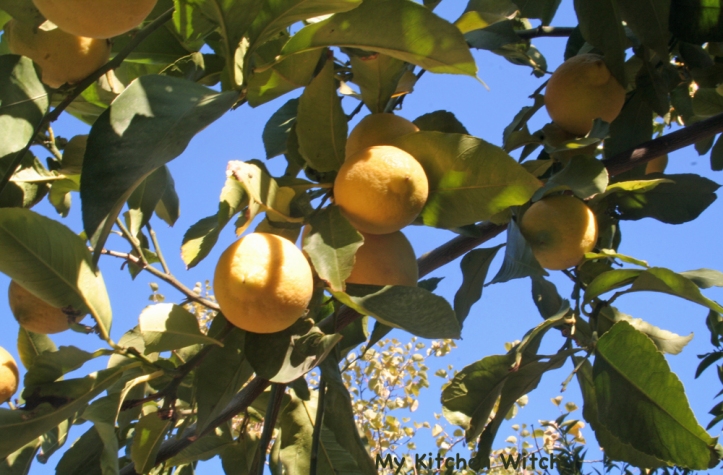
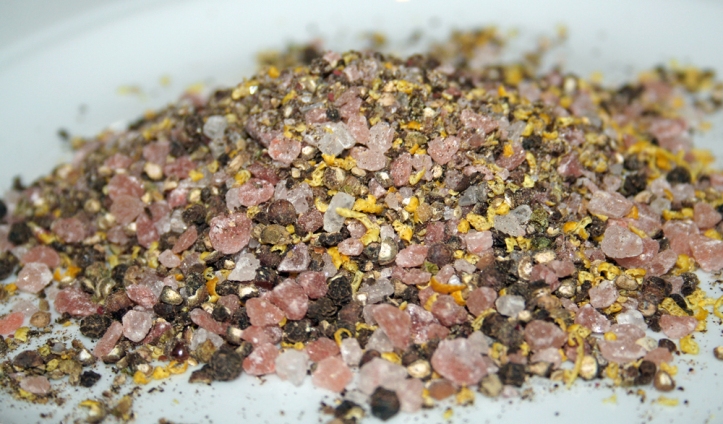

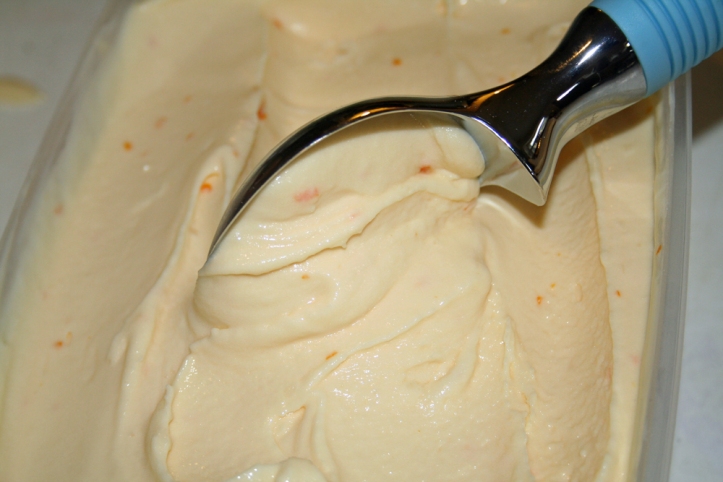


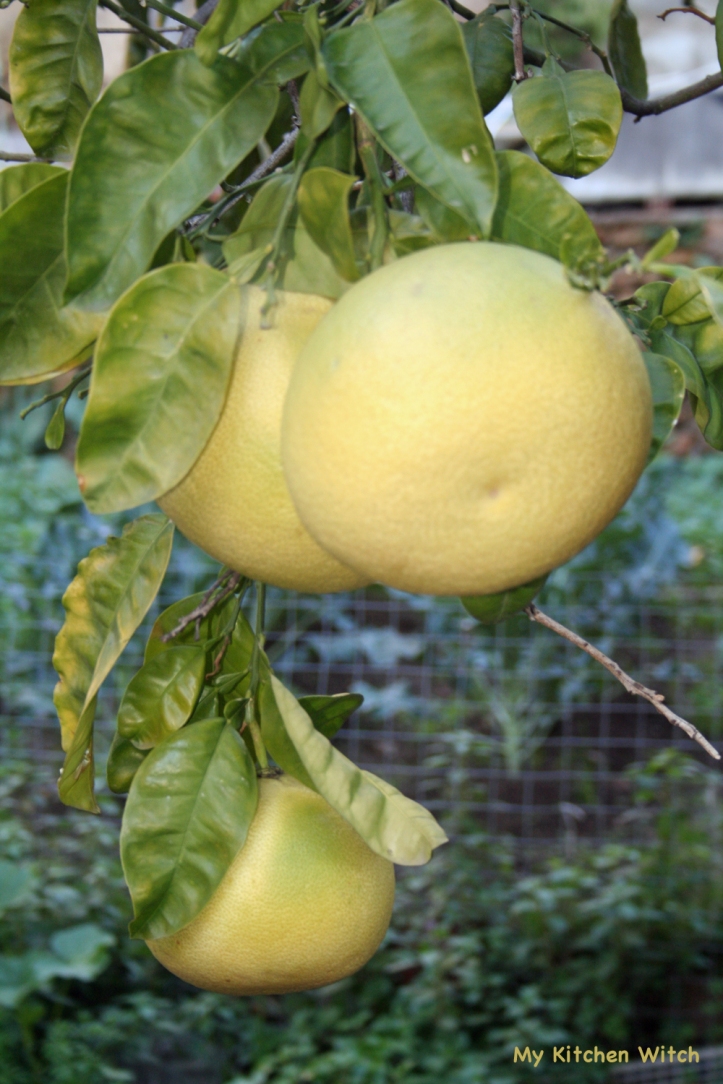
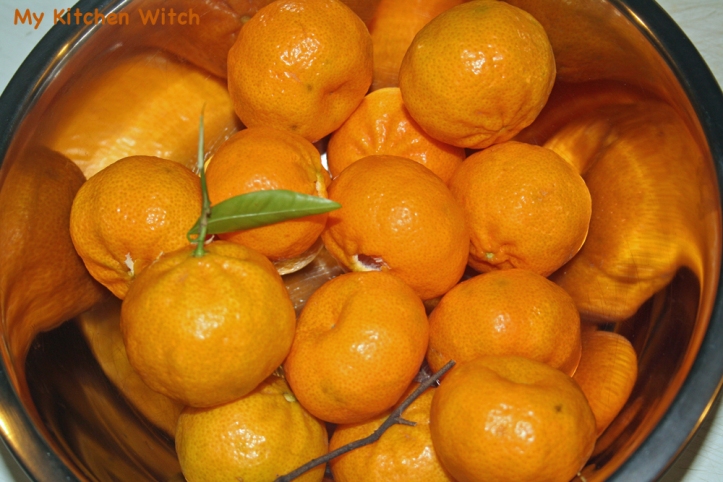
Love all the citrusy things you are making. Just delicious, especially that icecream… hmmmmmmm. My Greek neighbour uses both grapefruit and pomelo to make spoon sweets or Glyka with the rinds.
LikeLike
Hi Francesca, The ice cream is very creamy. I’ve made at least 10 batches of it so far, all for big dinners we host here. Everyone loves it. I had been told that the pomelo is generally used for its rind to make glyka and I may try it, but have to get through all the bitter orange glyka I was given. There is only so much glyka you can eat. I particularly like it sliced and on yoghurt with a few chopped pistachios. Great dessert (or breakfast!).
LikeLike
Yes, its a lovely thing in small doses.
LikeLiked by 1 person
How I envy you your wealth of citrus. And look at all of the dishes you’ve prepared! That’s fantastic, Debi. And I wouldn’t worry about not spending as much time as you’d like on WP. This is supposed to add to life not replace it. 🙂
LikeLike
John – WP does add to my life. There are so many of you wonderful people out there in blog land and it is nice to communicate. I am also loving the citrus plenty we are having at the moment. Very creative trying to find ways to use up the crops.
LikeLiked by 2 people
Citrus is a constant in my kitchen. I love them all. The limes are just beginning to come down in price, so I’m going to try your curd ice cream. We only have lemons imported from the US at the moment. I totally refuse to buy them. Sounds like your feet have hardly touched the ground since you arrived in Athens. I miss your erudite posts and considered comments, but life is much more important than WP.
LikeLike
Ah, limes! After being here one month, I had a lime tree planted. They say it should produce next year. Can’t wait! Next up is buying a kumquat. Am extending the citrus garden here. Don’t blame you in the least for not buying imported lemons. I wouldn’t either.
LikeLike
I had a potted cumquat I left in Melbourne. It thrived and fruited prolifically for 20+ years. Marmalade and cumquat brandy were a constant in my kitchen for that time
LikeLike
Kumquat brandy sounds good. Next time I’m at the garden centre, will pick up that plant. I have the ideal spot already picked out!
LikeLiked by 1 person
Wonderful citrussy post. Sometimes I candy orange peel but instead of drying it out, leave it in a jar in the syrup so that it’s soft when I want to use if for cakes.
LikeLike
Hi Anne, I dried them so they could be covered in chocolate. Very moreish. We preserve quartered and rolled rinds of bitter (i.e. Seville) oranges in a similar way and store them in syrup. It is a traditional Greek “spoon sweet” called glyko. Thanks for the idea of using the glyko in baking. I hadn’t thought to do so, but it makes perfect sense.
LikeLike
What a citrus bonanza you have going on! I really enjoy these IMK posts from yourself, Sandra and Francesca. Tops.
LikeLike
I’m with you there, Lisa – those IMK posts are enjoyed here, too. Really loving my citrus surplus!
LikeLiked by 1 person
Thank you for all the citrus recipes you shared with. I have several lemon trees , one of them being a Meyer Lemon Tree and my girlfriend has an orange tree that has the sweetest oranges ever. I will make the candied citrus peel and look for a lemon salt recipe.
LikeLike
We also have many trees – at least 3 each of lemon, mandarin, and sweet orange. One pomelo and at least half a dozen bitter oranges. The birds get quite a few – making gaping holes in the fruit to get to the juicy insides. We harvest what we need, but I also like to think ahead to summer with the potential of lemonade, citrus granitas and sorbets. We juice and freeze a lot!
LikeLike
Debi, it is easy to get overwhelmed with citrus fruit. I have nine trees and I have given up trying to use all the fruit.
LikeLike
Don’t worry, Glenda, the birds get their share, plus there are plenty of people around to hand out fruit to. I try my best, but I don’t worry about using the entire crop. It would drive me crazy if I tried!
LikeLike
What a richness of citrus you have. Thanks for all the suggestions. I only have one lone Meyer lemon tree but it is prolific. I have jars of lemon aigre-doux, preserved lemons, limoncello, and frozen juice but had not thought to candy the zest. Wonderful idea especially with the chocolate! Yum,
LikeLike
[…] – the νεραντζιά are also used quite effectively to make marmalade. I have also made candied peel (chocolate covered, of course), and lovely curd from the juice (used to make creamy ice creams). […]
LikeLike
[…] batches of the obligatory marmalade and making even more batches of (addictive) chocolate covered candied peel using the larger bitter oranges, I thought it might be time to explore uses for bitter Sevilles […]
LikeLike